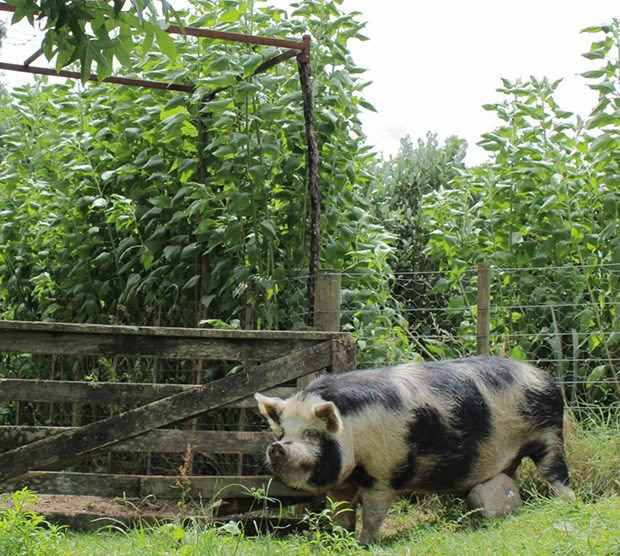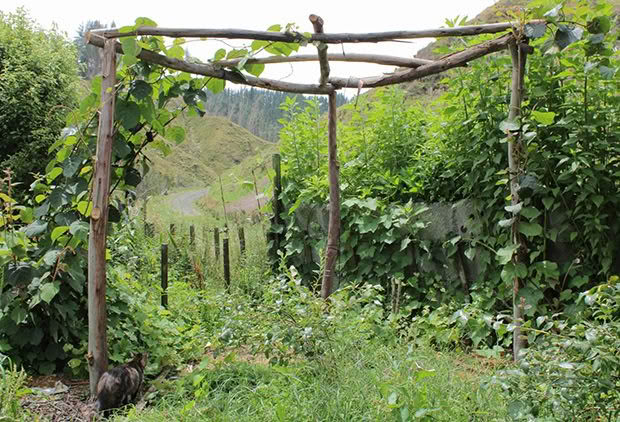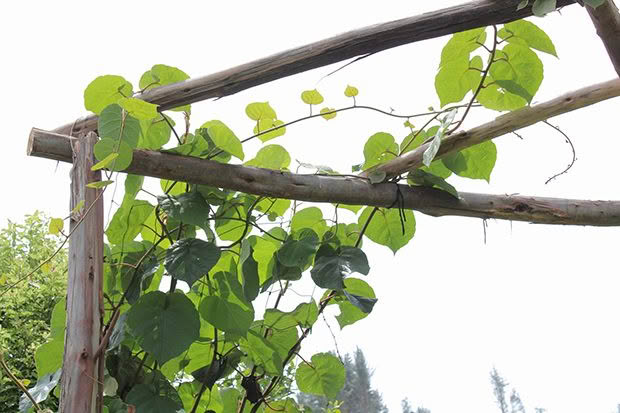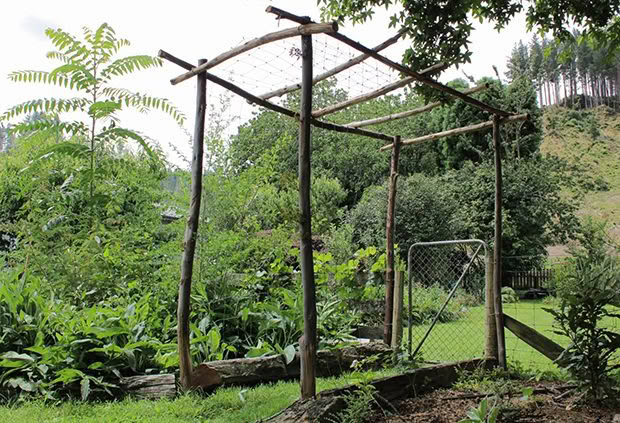Rebecca Stewart: Homegrown Pergolas

Rebecca takes measures to ensure that their trees last a few more lifetimes.
Photos: Summer Stewart
A year ago, the winds of Cyclone Gabrielle roared up our valley snapping fully grown trees as if they were twigs. It was a turbulent night of destruction. We listened to the cracking of limbs and trunks, followed by ground-shaking thumps as trees in the neighbour’s pine forest collapsed creating an apocalyptic scene in which trees resemble ‘pick up sticks’.
Out of destruction, however, have come new resources in the form of ground-durable timber. A gum tree at the far end of our property was one cyclone victim and, partially uprooted, it continued to grow while lying across a paddock. Most of our other gums line the cliff edge of our ravine and so are not easy to harvest. The windfall gum was a blessing.

We are interested in untreated ground-durable posts with the goal of eventually growing our own fence posts. Gum is one of the timbers used for this and, depending on the species, said to last 15 to 25 years in the ground. This longevity is comparable to treated pine posts so it makes sense to add growing our own posts to the list of homegrown goals.
The need of a pergola, to support our massive old kiwifruit (recovering from a hard prune back last winter), first took us down the paddock to begin the harvesting of gum poles. For the pergola we were able to utilise the narrower gum limbs, leaving the thicker sections for the fences. Straightish sections were cut from the fallen tree and dragged up the slope to a fence nearest to where we could park the ute and trailer, hefted over and loaded up. Some manuka poles were gathered from a harvested pine paddock further down the road. Many of these manuka trees were already dying as they have a lifespan of only 20 to 25 years and the timber is not as ground durable as gum. They will do to support our choko vines for many years.

For the pergola, we dug the gum posts approximately 800cm into the ground with the remaining shorter branches manoeuvred into place, then turned and adjusted until we had the best balance of look and fit. It is a slower construction process working with the natural curves and butts of the branches as there are no straight lines in nature. Their final position decided on, they were secured with large screws then wire and staples. Some recycled lengths of old hurricane netting were stapled up the sides and along the top to give the climbing plants extra support.

The rustic look of these pergolas suits our slightly wild and rambling gardens. Here old melds with the new, wood merges with the rusted metal and life thrives with diversity. The californian quails have claimed the tops of the pergolas as their territory so they can sound the alarm when prowling cats are spotted daring to enter the vicinity. The winding stems of the kiwi vine clambering profusely up the wires are threatening the quail perches. Further afield the tree lucerne, our orchard forest support trees, are giving their own height to the garden. Their soft grey-green foliage waves gently in the breeze as the ripening fruit swells on the orchard trees around them.
It is good to know that the massive gum, felled by a cyclone, will carry on being functional and giving us enjoyment for many more years. That makes up for the loss of its beauty on our skyline.
Read more about our upcycled, repurposed, creative DIY projects in our book Life on Fodder Farm – A Journey to Self-Sufficiency available in all good bookstores.

